Defending The Trips Formation
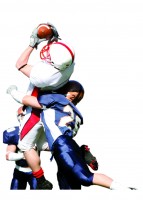 We defensive coaches would be foolish to think the number of teams running the spread offense in high school is going to decline anytime soon.
We defensive coaches would be foolish to think the number of teams running the spread offense in high school is going to decline anytime soon.
The top-tier teams in our conference all run versions of the spread offense. We utilize the 33 Stack defense and our coaching staff works hard on adjusting blitz concepts so as not to compromise our secondary coverages. Our “Buster” scheme, as we dubbed it, has been an integral part in defending against our spread opponents.
The Master Of DisguiseOne of the more popular spread-formation looks our opponents use is the Trips or 3-by-1 set. By having three receivers on one side — a wide receiver (WR) and two slot receivers, or, a WR off the line of scrimmage (LOS) with a slot receiver and a tight end — and a WR on the weak side, the offense creates an unbalanced-spread look, which challenges the defense to match up. When this occurs, the defense must account for three receivers on the strong side and the backside receiver, plus stopping the run.
The offense’s goal is to create misdirections to befuddle the defense. So, to counter this, your defense needs to disguise what it wants to accomplish — disguise a blitz or disguise the coverage.
The use of disguise in our Buster series is the solution to getting maximum coverage on the strong side, while preventing weak-side vulnerability — all the while serving a heavy dose of the blitz. Buster creates confusion and misreads by the QB. This leads to sacks, interceptions, fumbles, incompletions or stuffing runs.
Beating The Offense With ‘Buster’
Buster is an audible call out of our regular defense. The Buster audible series may appear complicated at first. When coaches break it down, however, it is easily taught. Our players have come to enjoy the problems Buster creates for opposing offenses. And, the “big play” opportunities for every defender on the field play an important role in the players learning their assignments.
One method we use is to “flop” our ends, spurs and outside linebackers (LB) in our 33 Stack defense. Aligned to the strong side are the defensive end (E in the diagrams), Sam Linebacker (SLB), and the Archer LB (a spur). Aligned on the weak side are the speed-end rusher (R), Will LB (WLB) and Lance (another spur).
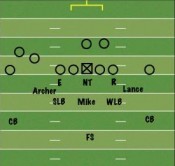 DIAGRAM 1: Buster Initial Pre-Snap Read. When the offense breaks the huddle and aligns in a trips formation, the defensive captain (usually the Mike LB) calls the Buster audible. To the offense, it still appears as if we are in our Base 33 look. The QB’s pre-read will, at this point, be a Cover 3 alignment.
DIAGRAM 1: Buster Initial Pre-Snap Read. When the offense breaks the huddle and aligns in a trips formation, the defensive captain (usually the Mike LB) calls the Buster audible. To the offense, it still appears as if we are in our Base 33 look. The QB’s pre-read will, at this point, be a Cover 3 alignment.
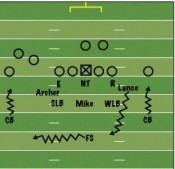 DIAGRAM 2: Buster Final Pre-Snap Read. As the QB sets (looks toward the center), the cornerbacks (CB) creep forward, the Lance begins his backpedal, and the free safety (FS) moves to the strong side.
DIAGRAM 2: Buster Final Pre-Snap Read. As the QB sets (looks toward the center), the cornerbacks (CB) creep forward, the Lance begins his backpedal, and the free safety (FS) moves to the strong side.
These movements now create a Cover 2 shell look for the QB’s read as he is in cadence.
The Archer stems, aligning with the No. 3 (inside slot) receiver. The Archer’s outside leg splits the No. 3 WR’s body.
The timing of the movement from what Diagram 1 shows to the look of Diagram 2 is determined by your coaches during game planning. From watching the opponent, here is a good rule of thumb: the moving defenders should watch the center.
Centers tend to look through their legs to get an accurate reference point of snapping the ball to the QB. Centers look up prior to snapping the ball. Between the initial QB cadence and the snap, the QB is seeing the defense shift into a Cover 2.
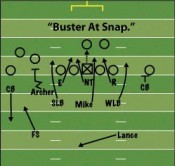 DIAGRAM 3: Buster At The Snap. When the ball is snapped, the defensive line and the LBs blast into their gap (rush) lanes. The Archer hits the No. 3 WR, which prevents (or at least slows down), his route running. The Archer is in man coverage with this WR. The strong-side CB breaks into deep-1/3 coverage. The FS charges into the hook-or-curl area. The Lance moves into middle-1/3 coverage. The backside CB plays press (and man) coverage, taking away the “hot” route or slant pattern. It is a six-man pass rush. If the running back (RB) flares out, the WLB breaks off his rush and prevents any flat pass.
DIAGRAM 3: Buster At The Snap. When the ball is snapped, the defensive line and the LBs blast into their gap (rush) lanes. The Archer hits the No. 3 WR, which prevents (or at least slows down), his route running. The Archer is in man coverage with this WR. The strong-side CB breaks into deep-1/3 coverage. The FS charges into the hook-or-curl area. The Lance moves into middle-1/3 coverage. The backside CB plays press (and man) coverage, taking away the “hot” route or slant pattern. It is a six-man pass rush. If the running back (RB) flares out, the WLB breaks off his rush and prevents any flat pass.
Defending Adjustments
After you stuff the basic trips formation a few times, the offense typically smartens up and adds some adjustments to its look.
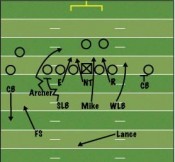 DIAGRAM 4: Buster Vs. Trips (WR/TE). If the formation is TE Trips, there is a minor adjustment to Buster. The SLB aligns head-up on the TE (No. 3 receiver) and the Archer blitzes from the outside position.
DIAGRAM 4: Buster Vs. Trips (WR/TE). If the formation is TE Trips, there is a minor adjustment to Buster. The SLB aligns head-up on the TE (No. 3 receiver) and the Archer blitzes from the outside position.
The speed option to the weak side is a popular running play for spread offenses and it is addressed within the Buster audible.
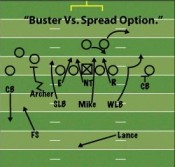 DIAGRAM 5: Buster Vs. Speed Option Weak. The Mike LB and rush end (R) are responsible for the QB, while the WLB breaks off the blitz and covers the pitch man. Even if the offensive tackle goes to the next level, leaving R as the option “read,” the WLB’s initial blitz makes for a difficult block.
DIAGRAM 5: Buster Vs. Speed Option Weak. The Mike LB and rush end (R) are responsible for the QB, while the WLB breaks off the blitz and covers the pitch man. Even if the offensive tackle goes to the next level, leaving R as the option “read,” the WLB’s initial blitz makes for a difficult block.
If the defense makes the “strength” call when the offense lines up in a 2-by-2 set, and when the offense motions to trips, the potential for confusion exists. To follow suit and audible to Buster would mean a wholesale shift of personnel from one side of the field to the other. To avoid such confusion, go with Buster Opp (see below).
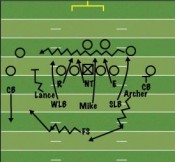 DIAGRAM 6: Buster Opp. The players stay put and are to perform the assignments normally run by the other side of the defense. It is one of the few instances where we do not follow our ‘flop’ rule. While it adds an additional learning step for the defense, it prevents the offense catching you out of position.
DIAGRAM 6: Buster Opp. The players stay put and are to perform the assignments normally run by the other side of the defense. It is one of the few instances where we do not follow our ‘flop’ rule. While it adds an additional learning step for the defense, it prevents the offense catching you out of position.
Offensive coordinators may notice the constant shifting of the defense when running Buster and decide to set up in trips formation initially, only to motion into a 2-by-2 look. Check out of Buster and run the original call made in the huddle…or run Minnie.
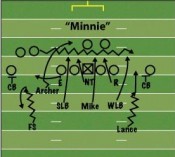 DIAGRAM 7: Minnie Check. Since Buster takes you to a Cover 2 shell, moving to Minnie is easy. Upon seeing a strong-side slot receiver motion to the weak side, both CBs move up into a press-man stance on the WRs. The Archer LB stems to the LOS. At the same time, the FS and Lance move into a Cover-0 look. The FS quickly stems back into deep zone. The QB notices the Archer LB ready for the pass rush. The QB may think the strong-side slot receiver is the “hot” choice, as the flat is vacated by the Archer LB. The FS is seven yards deep again, and even the SLB couldn’t get to the flat in time. When this occurs, now is the time to dial up a zone blitz.
DIAGRAM 7: Minnie Check. Since Buster takes you to a Cover 2 shell, moving to Minnie is easy. Upon seeing a strong-side slot receiver motion to the weak side, both CBs move up into a press-man stance on the WRs. The Archer LB stems to the LOS. At the same time, the FS and Lance move into a Cover-0 look. The FS quickly stems back into deep zone. The QB notices the Archer LB ready for the pass rush. The QB may think the strong-side slot receiver is the “hot” choice, as the flat is vacated by the Archer LB. The FS is seven yards deep again, and even the SLB couldn’t get to the flat in time. When this occurs, now is the time to dial up a zone blitz.
At the snap, E takes an initial step toward to offensive tackle. He then backs off into flat coverage. The Archer LB has taken his outside pass rush with the SLB blitzing the B-gap. The defense is still rushing six, and it becomes a “cat-and-mouse” game with the QB — that’s why the zone blitz is named Minnie.
The “Cincy” audible (see below) out of Buster is a weak-side CB blitz and is a second option for your defense against the offense motioning out of Trips and into a 2-by-2 formation.
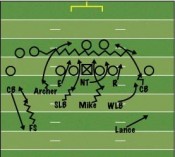 DIAGRAM 8: Cincy CB Blitz. This is a seven-man blitz and it works best when the ball is on the weak-side hash mark. From the Cover 2 look, the weak-side CB stems toward the motioning slot receiver. He sets up on the LOS, on the inside shoulder of the slot. You can give a corner-blitz look to the QB and bail out (perhaps into Minnie) or the CB can come hard at the snap.
DIAGRAM 8: Cincy CB Blitz. This is a seven-man blitz and it works best when the ball is on the weak-side hash mark. From the Cover 2 look, the weak-side CB stems toward the motioning slot receiver. He sets up on the LOS, on the inside shoulder of the slot. You can give a corner-blitz look to the QB and bail out (perhaps into Minnie) or the CB can come hard at the snap.
While the CB stems, the SLB and Mike LB stem to a 30 look; lining up 3 1/2 yards from the guards. The FS stems to a 1-by-7 look on the strong side. On the snap, the nose tackle (NT) stunts to the weak-side B-gap. The SLB and Mike LB blitz the A-gaps.
A delay blitz by the Mike LB may work best, depending on the direction the center takes. The WLB takes the flat coverage to look for the ‘hot’ route. The Lance covers the weak-side receiver deep, with the FS jumping the “hot” route by the strong-side slot or wide out.
For the empty formation (3-by-2 look with only the QB in the backfield), make a minor tweak.
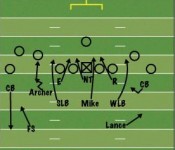 DIAGRAM 9: Buster Vs. Empty Backfield. The strong side remains the same. On the weak side, the CB takes an inside position as normal, but jumps the short zone at the snap. This defends the ‘hot’ read to the weak-side slot receiver. The Lance, instead of rotating to deep middle, plays a “loose” Cover 2 focusing on the WR.
DIAGRAM 9: Buster Vs. Empty Backfield. The strong side remains the same. On the weak side, the CB takes an inside position as normal, but jumps the short zone at the snap. This defends the ‘hot’ read to the weak-side slot receiver. The Lance, instead of rotating to deep middle, plays a “loose” Cover 2 focusing on the WR.
One thought on “Defending The Trips Formation”
Leave a Reply
You must be logged in to post a comment.






Here is a link which provides video of Buster. https://www.youtube.com/watch?v=gsmh6gRCbKQ